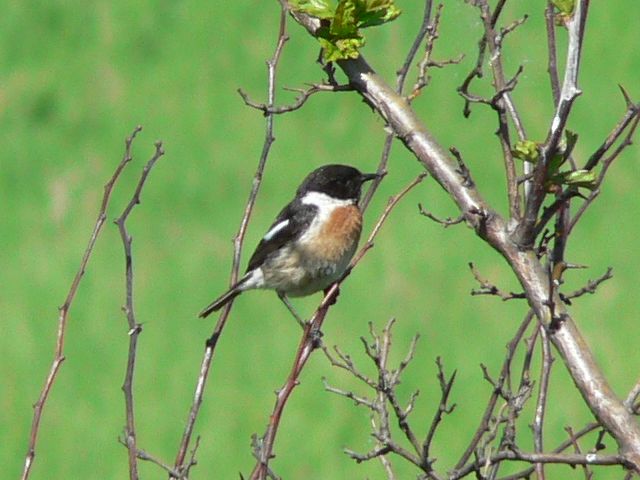- European Stonechat
Taxobox
name = European Stonechat

image_width = 300px
regnum =Animal ia
phylum = Chordata
classis =Aves
ordo = Passeriformes
familia =Muscicapidae
genus = "Saxicola "
species = "S. rubicola"
binomial = "Saxicola rubicola"
binomial_authority = (Linnaeus,1766 )
synonyms =see belowThe European Stonechat ("Saxicola rubicola" [
Etymology : "Saxicola", "rock-dweller", fromLatin "saxum", a rock + "incola", one who dwells someplace. "rubicola", "bramble-dweller", from Latin "rubus ", brambles + "incola", in reference to a favorite habitat.] )is a smallpasserine bird that was formerly classed as a member of the thrush family Turdidae but is now more generally considered to be anOld World flycatcher , family Muscicapidae. They, with similar small species in the family, are often called chats.The European Stonechat is somewhat smaller than the
European Robin . Both sexes have distinctively short wings, shorter than those of the more migratory Whinchat and Siberian Stonechat. The summer male "rubicola" has black upperparts, a black head, an orange throat and breast, and a white belly and vent. It also has white patches on the sides of its neck, a small white scapular patch on the wings, and a very small white patch on the rump often streaked with black. The female has paler brown upperparts and head, and no white neck patches, rump or belly, these areas being streaked dark brown on paler brown, the only white being the scapular patch on the wings and even this often being buffy-white.European Stonechats breed in heathland, coastal
dune s and roughgrassland with scattered smallshrub s andbramble , opengorse , tussocks or heather. They are non-migratory or short-distance migrants, with part of the population moving south to winter further south in Europe and more widely in north Africa.The male has a clicking call like stones knocking together, for which it was named. The song is high and twittering like a
Dunnock .Two doubtfully distinct
subspecies are accepted: the Central European Stonechat "S. r. rubicola" in the south and east of its range, and the Western European Stonechat of western and NW Europe, notably theAtlantic coastal areas, "S. r. hibernans". They are hardly different in appearance, butnDNA microsatellite fingerprinting reveals some degree of separation (Wink "et al." 2002). Together, these two races are found throughout western, central and southernEurope , the extreme northwest ofAfrica and westernTurkey .It is closely related to some species, several of which look also much alike to it:
*Siberian Stonechat , "Saxicola maura"
*African Stonechat , "Saxicola torquata"
*Réunion Stonechat , "Saxicola tectes"
*Fuerteventura Chat , "Saxicola dacotiae"In the past, these were generally considered
conspecific with the European Stonechat; especially the first two and the present species were long lumped together as "Common Stonechat" ("S. torquata"). A new review addingmtDNA cytochrome "b" sequence and nuclear DNA microsatellite fingerprinting evidence (Urquhart & Bowley 2002, Wink "et al." 2002) strongly supports their separation into distinct species. Note that molecular data was not acquired from "Saxicola torquata torquata" specimens but from "S. t. axillaris"; for a short time, the name "S. torquata" was thus erroneously used for the European Stonechat.Together with the Siberian and Fuerteventura species it constitutes eastern and western representatives of an
Eurasia n lineage; the Asian and European populations separated during theLate Pliocene orEarly Pleistocene , roughly 1.5-2.5 mya, and Fuerteventura was colonized by Western European of NW African birds somewhat later in the Early Pleistocene, about 1-2 mya (Wink "et al." 2002).References
* Urquhart, Ewan & Bowley, Adam (2002): "Stonechats. A Guide to the Genus Saxicola". Christopher Helm, London. ISBN 0-7136-6024-4
* Wink, M.; Sauer-Gürth, H. & Gwinner, E. (2002): Evolutionary relationships of stonechats and related species inferred from mitochondrial-DNA sequences and genomic fingerprinting. "
British Birds " 95: 349-355. [http://www.uni-heidelberg.de/institute/fak14/ipmb/phazb/pubwink/2002/28.2002.pdf PDF fulltext]External links
* [http://www.oiseaux.net/oiseaux/photos/tarier.patre.html Oiseaux] Photos
* [http://www.ibercajalav.net/img/334_StonechatStorquatus.pdf Ageing and sexing (PDF) by Javier Blasco-Zumeta]
Wikimedia Foundation. 2010.
